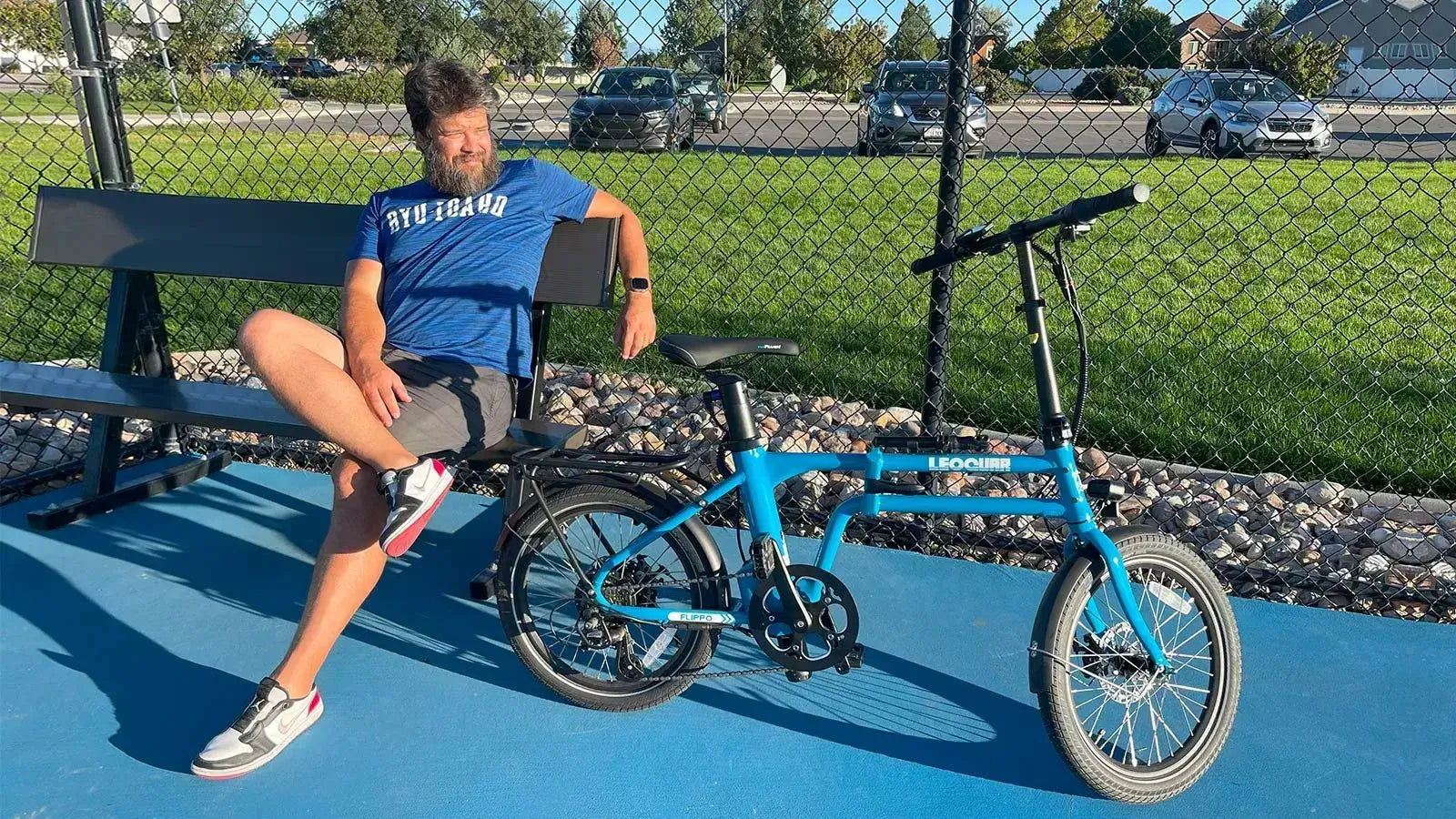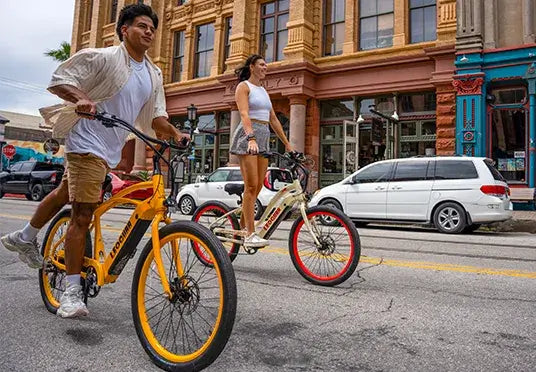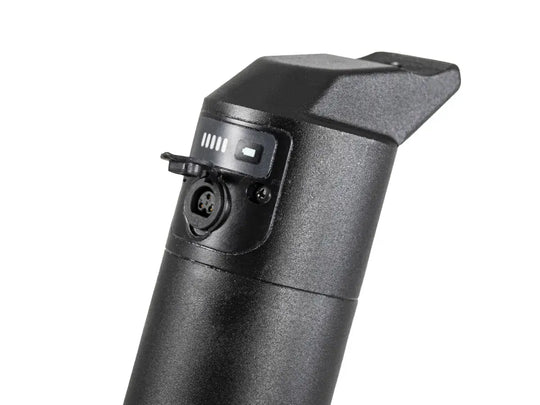
Electric Bike Laws in the United States: Know Before You Ride
Understanding Electric Bike Laws
E-bikes are revolutionizing transportation. They offer a thrilling blend of eco-friendly transportation, exercise, and exploration. But before you hop on and zip off into the sunset, it's crucial to familiarize yourself with electric bike laws in the United States.
These laws vary significantly from state to state, and unknowingly breaking a regulation could land you a ticket or put you in a dangerous situation. We understand the excitement running through your veins as you hop on your Leoguar folding motor bike to hit the open road. However, taking a few minutes to understand the legal landscape in your area will ensure a smooth, enjoyable, and, most importantly, safe ride. In this article, we’ll look into e-bike legislation and explore the importance of knowing the rules before you roll.
At Leoguar, we've spent years developing and testing electric bikes designed to comply with U.S. regulations and meet riders' real-world needs. Our team works closely with state-level compliance experts to ensure each model, from our city cruisers to off-road fat tire e-bikes, aligns with evolving electric bike laws across the country.
Classifying Ebikes Under US Law
Now that you know the importance of electric bike laws, let's break down how these laws categorize different types of e-bikes. Here at Leoguar, we build our bikes with these classifications in mind, so familiarizing yourself with them will ensure legal riding and help you choose the Leoguar e-bike that best suits your needs.
| E-bike Class | Max Assisted Speed | Pedal Assist | Throttle | Where You Can Ride | Helmet Required? |
|---|---|---|---|---|---|
| Class 1 | 20 mph | ✅ Yes | ❌ No | Bike lanes, paths, streets | Usually under 18 |
| Class 2 | 20 mph | ✅ Yes | ✅ Yes | Often same as Class 1, but check local laws | Usually under 18 |
| Class 3 | 28 mph | ✅ Yes | ❌ No | Streets and some bike lanes (varies by state) | Often mandatory for all ages |
There are three main classes of e-bikes under US law. Each class has speed, operation, and usage regulations on specific roadways. Let's dive into each category:
Class 1 E-bikes
These bikes feature a motor that only kicks in when you're actively pedaling, and they typically stop assisting when you reach 20 mph. They're an excellent choice for cruising around town, getting exercise with a boost, and enjoying scenic rides without breaking a sweat. The best part is that Class 1 e-bikes are like regular bicycles under US law. This means you can ride them on most bike paths, streets, and designated bike lanes, just like a traditional bike.
Class 2 Ebikes
If you want more flexibility in your ride, Class 2 is your go-to e-bike. These e-bikes offer both a pedal assist and a throttle. The motor on a Class 2 e-bike still cuts off at 20 mph, but the throttle allows you to engage the motor without pedaling, perfect for getting start on hills or taking a break from pedaling momentarily. However, there can be some variation in regulations for Class 2 e-bikes depending on your state. We'll explore this further in a later section, but for now, remember – always check your local electric bike rules before heading out on your Class 2 adventure.
Class 3 Ebikes
For riders who crave a bit more speed, there are Class 3 e-bikes. These e-bikes offer pedal assist only, but the motor can assist up to 28 mph. This makes them ideal for commuting longer distances or tackling hillier terrain. It's important to note that Class 3 e-bikes are often subject to more restrictions than Class 1 and 2. In some states, regulations require riders to be 16 or older with a driver's license, or they prohibit e-bikes on bike paths.. Remember, a little research goes a long way – we'll provide resources to help you navigate the legalities of Class 3 e-bikes in your area.
Certain models of LeoGuar, such as the Fastron fat tire electric bike for adults, are initially categorized as Class 2 ebikes. Yet, riders can choose to increase the speed from 20 mph to 28 mph, thus upgrading the Leoguar to a Class 3 ebike.
Beyond E-bike Classes: Other Legal Considerations
Knowing the three classes is just the beginning. You need to understand other important rules to make sure your electric bike is a street legal electric bike.
Motor Power Limits
The federal limit is 750W, but this usually means the motor's "normal" power output. Many e-bikes can make more "peak" power for short times. But be careful of e-bikes with motors rated at 1000W, 1500W, or higher. These bikes almost always fall outside the legal definition of an electric bicycle. They get classified as mopeds, motor-driven cycles, or motorcycles, which means you need a driver's license, registration, and insurance.
Battery Safety and UL Standards
People are worried about battery fires, so safety has become very important. Many places, especially New York City, now require that all electric bikes sold must have batteries and electrical systems certified to the Underwriters Laboratories (UL) standard 2849. This certification means the system has been tested carefully for fire and electrical safety. When you buy a new e-bike, look for a UL 2849 certification sticker. It shows quality and helps prepare for the future as more areas adopt these safety standards.
Registration and Licensing
One great thing about e-bikes is that most places don't require registration, license plates, or a driver's license. However, this isn't true everywhere. A few states have special laws that treat some or all e-bikes like motor vehicles, which means you need these things. For example, states like Alabama, Alaska, and New Mexico treat e-bikes more like mopeds and require registration and a license. People in these states need to know about these exceptions to avoid big penalties.
Federal vs. State Electric Bike Laws: What’s the Difference?
E-bike laws have two main parts: federal and state. You need to understand what each one does. Federal law, specifically the Consumer Product Safety Act, created a basic definition to tell e-bikes apart from motor vehicles like mopeds and motorcycles.
Under federal law, a "low-speed electric bicycle" is a two or three-wheeled vehicle with working pedals and an electric motor of less than 750 watts. The law also says that its top speed on flat pavement, when powered only by the motor, is less than 20 mph.
But this federal definition is mainly for making and safety standards. It makes sure that qualifying e-bikes are treated as consumer products like regular bicycles rather than as motor vehicles by federal agencies. It does not say how they should be used on public roads. States have that power. State and local governments decide the specific rules of the road. All legal interpretations in this article are based on public information from the U.S. Consumer Product Safety Commission (CPSC), state DMV guidelines, and recent updates from major transportation regulatory bodies. They decide things like:
- License and registration needs (most states require none for e-bikes).
- Minimum age for riders.
- Helmet laws.
- Where different classes of e-bikes can be used (like streets, bike lanes, sidewalks, trails).
While federal law gives a foundation, your state's specific electric bike laws are what you must follow for daily riding.
State-Level Regulations: Navigating the E-bike Landscape
Our team has meticulously compiled this 2025 e-bike regulation overview from each state's Department of Transportation and legislative databases to provide the most accurate, up-to-date legal guidance available. We've covered the three main e-bike classifications under US law, but here's the thing: e-bike regulations get more nuanced when you zoom in on individual states. Think of it like a choose-your-own-adventure story – each state has its chapter in the electric bike rules book. While there are some general similarities, there can also be variations, so it's crucial to understand the specific rules where you live and ride.
Variations in State E-bike Laws: A State-by-State Breakdown
Let's delve into a state-by-state breakdown, focusing on some key regions. We'll provide a more comprehensive list of resources later to help you determine your state's specifics.
Alabama
- Classification: Does not use the 3-class system and treats e-bikes as "motor-driven cycles."
- Requirements: Requires a driver's license, registration, and a license plate.
- Helmet Law: Required for all riders.
- Minimum Age: 14.
Alaska
- Classification: Does not use the 3-class system and calls an e-bike a "motor-driven cycle" unless local laws say otherwise.
- Requirements: Requires a driver's license and registration.
- Helmet Law: Required for riders under 18.
- Minimum Age: 16 to be licensed.
Arizona
- Classification: Uses the 3-class system.
- Requirements: No license or registration required.
- Helmet Law: Required for all riders under 18.
- Where to Ride: Class 1 and 2 allowed on bike paths, but Class 3 must stay on roadways.
Arkansas
- Classification: Uses the 3-class system.
- Requirements: No license or registration required.
- Helmet Law: Required for riders under 21.
- Minimum Age: No statewide minimum, but 16 for Class 3.
California
- Classification: Uses the 3-class system.
- Requirements: No license or registration required.
- Helmet Law: Required for Class 3 riders of any age and all riders under 18.
- Minimum Age: 16 for Class 3.
Colorado
- Classification: Uses the 3-class system.
- Requirements: No license or registration required.
- Helmet Law: No statewide helmet law.
- Where to Ride: Local governments can restrict use on paths.
Connecticut
- Classification: Uses the 3-class system.
- Requirements: No license or registration required.
- Helmet Law: Required for all riders under 16.
- Minimum Age: 16 for Class 3.
Delaware
- Classification: Uses the 3-class system.
- Requirements: No license or registration required.
- Helmet Law: Required for all riders under 18.
- Minimum Age: 16 for Class 3.
Florida
- Classification: Uses the 3-class system and legally considers e-bikes as "bicycles."
- Requirements: No license or registration required.
- Helmet Law: Required for riders under 16.
- Minimum Age: 16 to operate an e-bike on public roadways.
Georgia
- Classification: Uses the 3-class system.
- Requirements: No license or registration required.
- Helmet Law: Required for all riders under 16.
- Minimum Age: 15 for Class 3.
Hawaii
- Classification: Does not use the 3-class system and defines e-bikes as "low-speed electric bicycles."
- Requirements: Registration is required, but no driver's license needed.
- Helmet Law: Required for riders under 16.
- Minimum Age: 15.
Idaho
- Classification: Uses the 3-class system.
- Requirements: No license or registration required.
- Helmet Law: No statewide helmet law.
- Where to Ride: Class 3 restricted to roadways unless local laws allow them elsewhere.
Illinois
- Classification: Uses the 3-class system.
- Requirements: No license or registration required.
- Helmet Law: No statewide helmet law.
- Where to Ride: Class 3 restricted to roadways.
Indiana
- Classification: Uses the 3-class system.
- Requirements: No license or registration required.
- Helmet Law: Required for riders under 18.
- Minimum Age: 15.
Iowa
- Classification: Uses the 3-class system.
- Requirements: No license or registration required.
- Helmet Law: No statewide helmet law.
- Minimum Age: No statewide minimum.
Kansas
- Classification: Does not use the 3-class system and regulates e-bikes as traditional bicycles.
- Requirements: No license or registration required.
- Helmet Law: Required for riders under 15.
- Minimum Age: No statewide minimum.
Kentucky
- Classification: Regulates e-bikes as traditional bicycles.
- Requirements: No license or registration required.
- Helmet Law: Required for riders under 21 if on a Class 3 e-bike equivalent.
- Minimum Age: 16 to operate a Class 3 e-bike equivalent.
Louisiana
- Classification: Uses the 3-class system.
- Requirements: No license or registration required.
- Helmet Law: Required for all riders under 12.
- Minimum Age: No statewide minimum.
Maine
- Classification: Uses the 3-class system.
- Requirements: No license or registration required.
- Helmet Law: Required for all riders under 16.
- Minimum Age: 16 for Class 3.
Maryland
- Classification: Uses the 3-class system.
- Requirements: No license or registration required.
- Helmet Law: Required for all riders under 16.
- Minimum Age: 16 for Class 3.
Massachusetts
- Classification: Does not use the 3-class system and classifies e-bikes as "motorized bicycles."
- Requirements: License or learner's permit required, and registration may be required.
- Helmet Law: Required for all riders.
- Minimum Age: 16.
Michigan
- Classification: Uses the 3-class system.
- Requirements: No license or registration required.
- Helmet Law: No statewide helmet law.
- Where to Ride: Class 2 and 3 may be restricted on some trails.
Minnesota
- Classification: Uses the 3-class system.
- Requirements: No license or registration required.
- Helmet Law: No statewide helmet law.
- Minimum Age: 15.
Mississippi
- Classification: Uses the 3-class system.
- Requirements: No license or registration required.
- Helmet Law: No statewide helmet law.
- Minimum Age: No statewide minimum.
Missouri
- Classification: Uses the 3-class system.
- Requirements: No license or registration required.
- Helmet Law: No statewide helmet law.
- Minimum Age: No statewide minimum.
Montana
- Classification: Defines an "electrically assisted bicycle" separate from the 3-class system.
- Requirements: No license or registration required.
- Helmet Law: No statewide helmet law.
- Minimum Age: No statewide minimum.
Nebraska
- Classification: Uses the 3-class system.
- Requirements: No license or registration required.
- Helmet Law: No statewide helmet law.
- Minimum Age: No statewide minimum.
Nevada
- Classification: Uses the 3-class system.
- Requirements: No license or registration required.
- Helmet Law: No statewide helmet law.
- Minimum Age: 16 for Class 3.
New Hampshire
- Classification: Uses the 3-class system.
- Requirements: No license or registration required.
- Helmet Law: No statewide helmet law.
- Minimum Age: 16 for Class 3.
New Jersey
- Classification: Defines two classes of e-bikes with max speeds of 20 mph or 28 mph.
- Requirements: No license required, but registration required for bikes faster than 20 mph.
- Helmet Law: Required for all riders under 17.
- Minimum Age: 15 for e-bikes, 16 for faster "low-speed electric bicycles."
New Mexico
- Classification: Does not use the 3-class system and treats e-bikes as "mopeds."
- Requirements: Requires a driver's license and registration.
- Helmet Law: Required for riders under 18.
- Minimum Age: 13.
New York
- Classification: Uses the 3-class system.
- Requirements: No license or registration required.
- Helmet Law: Required for Class 3 riders of any age and all riders under 14.
- Minimum Age: 16, and NYC has specific rules, including requiring UL 2849 certification.
North Carolina
- Classification: Defines e-bikes but does not use the 3-class system.
- Requirements: No license or registration required.
- Helmet Law: Required for riders under 16.
- Minimum Age: 16.
North Dakota
- Classification: Uses the 3-class system.
- Requirements: No license or registration required.
- Helmet Law: No statewide helmet law.
- Minimum Age: No statewide minimum.
Ohio
- Classification: Uses the 3-class system.
- Requirements: No license or registration required.
- Helmet Law: No statewide helmet law.
- Minimum Age: 16 for Class 3.
Oklahoma
- Classification: Uses the 3-class system.
- Requirements: No license or registration required.
- Helmet Law: No statewide helmet law.
- Minimum Age: 16 for Class 3.
Oregon
- Classification: Uses a 4-tier system similar to the 3-class system but with an added category for cargo e-bikes.
- Requirements: No license or registration required.
- Helmet Law: Required for riders under 16.
- Minimum Age: 16.
Pennsylvania
- Classification: Defines "pedalcycle with electric assist" with max speed 20 mph and 750W motor.
- Requirements: No license or registration required.
- Helmet Law: Required for riders under 12.
- Minimum Age: 16.
Rhode Island
- Classification: Regulates e-bikes as traditional bicycles.
- Requirements: No license or registration required.
- Helmet Law: Required for riders under 15.
- Minimum Age: 16.
South Carolina
- Classification: Regulates e-bikes as traditional bicycles.
- Requirements: No license or registration required.
- Helmet Law: No statewide helmet law.
- Minimum Age: No statewide minimum.
South Dakota
- Classification: Uses the 3-class system.
- Requirements: No license or registration required.
- Helmet Law: No statewide helmet law.
- Minimum Age: No statewide minimum.
Tennessee
- Classification: Uses the 3-class system.
- Requirements: No license or registration required.
- Helmet Law: Required for riders under 16.
- Minimum Age: 14.
Texas
- Classification: Uses the 3-class system.
- Requirements: No license or registration required.
- Helmet Law: No statewide helmet law.
- Minimum Age: 15 for Class 3.
Utah
- Classification: Uses the 3-class system.
- Requirements: No license or registration required.
- Helmet Law: No statewide helmet law.
- Where to Ride: Class 3 restricted to roadways.
Vermont
- Classification: Uses the 3-class system.
- Requirements: No license or registration required.
- Helmet Law: No statewide helmet law.
- Minimum Age: 16.
Virginia
- Classification: Uses the 3-class system.
- Requirements: No license or registration required.
- Helmet Law: No statewide helmet law.
- Minimum Age: 14.
Washington
- Classification: Uses the 3-class system.
- Requirements: No license or registration required.
- Helmet Law: No statewide helmet law, but local laws may require them.
- Minimum Age: 16 for Class 3.
West Virginia
- Classification: Uses the 3-class system.
- Requirements: No license or registration required.
- Helmet Law: Required for riders under 15.
- Minimum Age: 16 for Class 3.
Wisconsin
- Classification: Uses the 3-class system.
- Requirements: No license or registration required.
- Helmet Law: No statewide helmet law.
- Minimum Age: 16 for Class 3.
Wyoming
- Classification: Uses the 3-class system.
- Requirements: No license or registration required.
- Helmet Law: No statewide helmet law.
- Minimum Age: No statewide minimum.

Electric Bike Laws in Non-Tiered States: Key Exceptions & Nuances
While many states categorize e-bikes into Classes 1, 2, and 3, some still need to adopt this tiered system. This can mean regulations vary more widely. Here, we'll explore some key considerations in non-tiered states. In non-tiered states, the focus might shift to specific speed limits and motor power restrictions. For example, some might allow e-bikes with a motor under 750 watts to operate similarly to regular bicycles. These states might also have specific requirements for riders. This could include a minimum age, helmet use regulations or registration requirements.
How to Ride Your E-bike Legally and Responsibly
From our experience riding in different places, we've learned that state laws are only part of the story. As electric bike riders ourselves, we’ve encountered the challenges of navigating inconsistent local rules. That’s why we advocate for better signage, rider education, and more consistent national standards in future policy discussions. To stay truly legal and safe, you need to think about local rules and ride carefully.
Think Local
City and county laws can be stricter than state laws. A state might allow Class 2 e-bikes on bike paths, but a specific city park might not allow them. To check local rules, start with the city's parks and recreation website or look up the city laws online. If you can't find clear information, a quick call to the local police department can often help.
Navigating Trails and Parks
Trail access is one of the most confusing parts of owning an e-bike. Pay close attention to signs at trail entrances. A sign that says "No Motorized Vehicles" can be tricky to understand. In many places that define e-bikes as bicycles, this sign doesn't apply to Class 1 or 2 e-bikes. However, in other areas, or for people who manage the land and don't know the current e-bike laws, it might mean all e-bikes are banned. Always let pedestrians and horse riders go first, and know the local rules for riding electric bicycles on trails before you ride.
Traveling with Your E-Bike
Taking your e-bike to a new state? Use this quick checklist to make sure you're following the rules:
- ✅ Know your e-bike class (1, 2, or 3)
- ✅ Confirm your state’s licensing & helmet rules
- ✅ Check local park or trail regulations
- ✅ Make sure your motor power is under 750W
- ✅ Look for a UL 2849 certified battery sticker
- ✅ If traveling, research the destination state’s laws
- ✅ Always ride predictably and yield on trails
Bottom Line
Remember, following electric bicycle laws isn't just about staying on the right side of the law – it's about safety. Understanding the rules fosters a more predictable environment for everyone on the road or trail. By being a responsible e-bike rider, you contribute to a positive experience for yourself and others.
Ready to ride smarter, safer, and legally? At Leoguar, we don’t just build e-bikes — we help you navigate the road ahead. Explore our full range of street-legal electric bikes, compare classes, and ride with confidence backed by expert guidance.
📩 Have questions or stories to share? Drop a comment below — we’d love to hear from riders across the U.S.!
Frequently Asked Questions
1. Q: Do I need a license to ride an electric bike?
A: In most states, you don't need a license to ride an electric bike. However, some states like Alabama, Alaska, Massachusetts, and New Mexico do require a driver's license or permit. Check your state's specific requirements in our guide above.
2. Q: What's the difference between Class 1, Class 2, and Class 3 e-bikes?
A: Class 1 e-bikes only assist when you pedal and stop helping at 20 mph. Class 2 e-bikes can move without pedaling (throttle) but also stop at 20 mph. Class 3 e-bikes only assist when pedaling but can go up to 28 mph, though they often have more restrictions.
3. Q: Can I ride my e-bike on bike paths and trails?
A: It depends on your e-bike class and local rules. Generally, Class 1 and 2 e-bikes are allowed on most bike paths, while Class 3 e-bikes are often restricted to roadways. Always check local signs and regulations, as cities and parks can have their own rules.
4. Q: Do I need to wear a helmet when riding an e-bike?
A: Helmet requirements vary by state and age. Some states require helmets for all riders, others only for minors, and some have no helmet laws at all. Class 3 e-bikes often have stricter helmet requirements. Check your state's specific helmet laws in our detailed guide.
5. Q: What happens if my e-bike motor is more powerful than 750 watts?
A: E-bikes with motors over 750 watts typically don't qualify as bicycles under most state laws. They're usually classified as mopeds, motorcycles, or motor vehicles, which means you'll need a license, registration, and insurance to ride them legally.









































Leave a comment